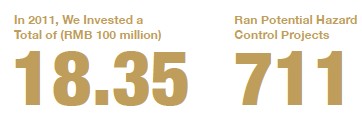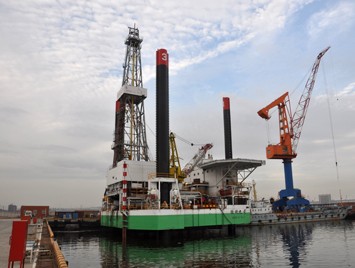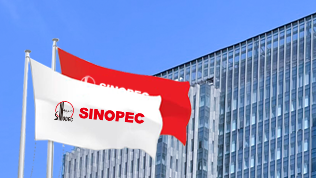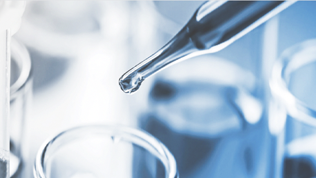Intrinsic Safety
For high risk industries like energy industry, any neglect of work, irregular operation or potential hazard might cause accidents, leading to lose of properties or even people's lives. We have made enormous efforts to enhance safety awareness among staff, site safety management and potential hazard control, in order to develop into an intrinsically safe company. In 2011, there were 11 reported accidents, one fewer than last year and there were three deaths, the same as last year. There were no accidents that needed to be reported to State Administration of Work Safety, Ministry of Environmental Protection or State-owned Assets Supervision and Administration Commission of the State Council.
"I Safe"
A person is the most criticle link in production and operation. Focusing on forging a safety-oriented corporate culture, we make major efforts to motivate staff involvement in ensuring safe production.
The year of 2011 is the third year of "I Safe" campaign. We compiled a collection of good examples during the past three years for every employee to follow, and encouraged searching of weak links, with 170,000 weak links found out and nearly 120,000 pieces of advice made. By participating in "I Safe" activities, staff's safety awareness has been enhanced, their sense of responsibility sharpened, and unsafe behavior enormously reduced. In 2011, the number of reported accidents and that of reported deaths fell by 38.9% and 57.1% respectively compared with 2008 (before the "I Safe" campaign started).

On-Site Safety Management
After analyzing past accidents, we have found out that command and operation against rules and violation of labor discipline are the primary causes of accidents, and most accidents take place in direct operations. To address these problems, we have developed and put into practice Sinopec Ban on Irregular Behavior in Production. We strictly follow regulations on operation license and safety checking, and have taken concrete measures to guard against occurrence of accidents.
In 2011, we continued to strengthen site supervision of key facilities and locations during special period and special operations. In refining and petrochemical subsidiaries, we set 240 positions of grassroots safety supervisors. Requirements of "Seven Remembers and Seven Don'ts" were introduced to site operations. The emphasis of safety management shifted to the grassroots level. Efforts were made to ensure thorough investigation and proper handling of accidents. Two heads of subsidiaries were held accountable for accidents.
Potential Hazard Control
Potential hazards, if happening, could undermine safe production. Therefore, potential hazard control is one of our principal ways to lower accident rate. We always ensure funding for potential hazard control in making the annual budget. We have formulated Regulations on Potential Hazard Control Project and strictly follow it in daily work. We apply 4W management to potential hazard control projects, which means to define what to be done to improve safety management, where the fund comes from, who is in charge and when the project should be completed. With many years of input of manpower and funding, all production facilities have realized safe, stable, longtime and optimal operation, and we have achieved a higher level of intrinsic safety.
In 2011, the focus of potential hazard control was placed upon well control devices, liquid hydrocarbon spheres, instruments, emergency response system, tank depot fire-fighting system, thermal oil pump sealing, loading of light oil and chemical products, and long-distance pipelines.

 Shengli-9 Platform Upgraded and Undocked
Shengli-9 Platform Upgraded and Undocked
R&D
In 2011, we completed phase one of HSE management system pilot project, and the model of HSE information system of main business segments began to take shape. Study has started on high risk chemical transportation, real-time tilt monitoring of mobile offshore platform, and long-distance pipeline safety.

 Address
Address Post code
Post code Tel
Tel









 京公网安备11010502035639
京公网安备11010502035639